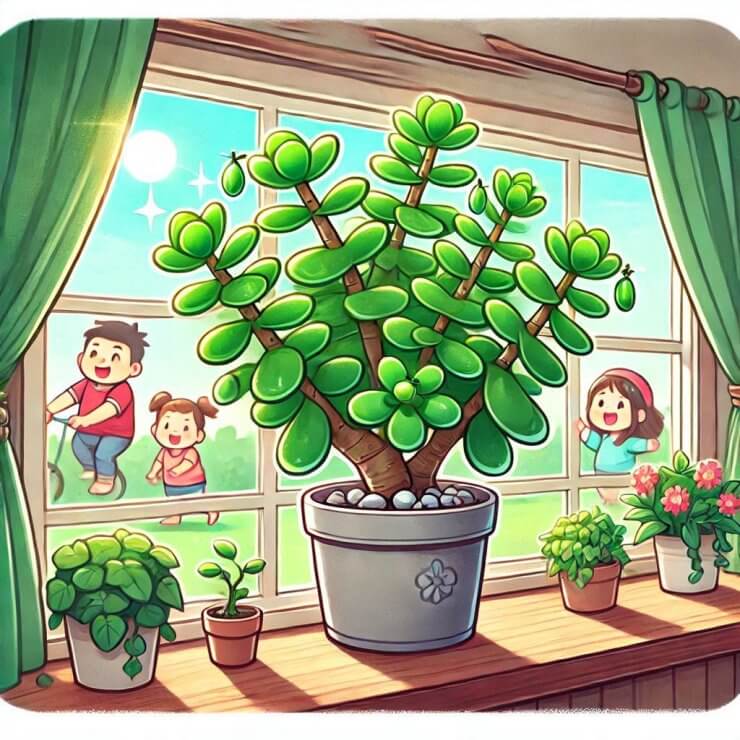Read by Matilda Longbottom

I’ve always had a black thumb, much to my grandmother’s chagrin. She could grow anything, and I grew up marveling at her abundant garden. The fresh produce was a delightful bonus, but despite my admiration and her guidance, I seemed destined to doom every plant I touched.
I’ve attempted everything: seed starting, container gardening, regular gardening, planting “easy” flowers in a flower box, even buying fully grown plants and tending them. Inevitably, they withered under my care. It wasn’t on purpose, it just sort of…happened. This talent for unintentionally killing plants made the success of my grandmother’s jade plant cutting all the more surprising and meaningful.
When my husband and I got married, we moved into a one-bedroom apartment in the basement of my grandmother’s house. We had our first child there and two more in quick succession. In those hectic early years, while we paid rent and helped around the house, Grandma offered a steady stream of unsolicited advice. Some of it, like putting sugar on a baby’s tongue to stop hiccups, was questionable. But her advice about plants was always spot on.
One Spring, she handed me a cutting from her beloved jade plant. “This is probably the easiest plant to grow,” she assured me. “Just leave the end of it in a little water near a window, and it will grow roots. Eventually, you can plant it.” Skeptical but hopeful, I followed her instructions. To my amazement, the cutting grew roots, and I planted it in a small pot.
At first, I overwatered it, and it started to look terrible. Grandma’s advice came to the rescue: “Be patient with yourself and the plant. The plant will tell you what it needs. Only water it when the soil feels dry, or the roots will rot.” I took her advice, and soon the jade plant began to thrive.
Months passed, and the jade plant started to look a bit peaked again. “It needs more sunshine,” Grandma advised. I moved it to the sunniest window in our apartment, and once again, it began to flourish. Eventually, it grew so well that I had to transplant it into a larger pot.
After five years, our family had outgrown our little basement apartment. When we moved, we took the jade plant with us, promising Grandma we’d visit every week. Despite the change, the jade continued to grow, although it did start to lose leaves. I suspected it missed Grandma, but she reminded me, “The plant will tell you what it needs. Check the soil each day.” With life busier than ever, I had neglected this task. I made a point to water it regularly, and it revived once more.
Life with toddlers was chaotic, and one day, the jade plant was knocked over during a bout of wrestling. A part of it broke off. Unsure of what to do, I turned to Grandma. “Make new cuttings,” she advised, “and grow them the same way you did the first one.” I followed her instructions, and soon I had four thriving jade plants. My confidence in my green thumb was growing, even if prematurely.
Despite my ongoing failures with other plants—tropical plants, spider plants, a kalanchoe, and even a vegetable garden—the jade plants endured. When Grandma passed away, I found solace in caring for these resilient plants. They became a living testament to her enduring spirit.
I kept the original jade plant and gave the other three to my aunts, Grandma’s daughters. I shared Grandma’s wisdom with them: “Your plant will tell you what it needs. Water only when the soil is dry, and ensure it gets plenty of sunlight.”
“Your plant will tell you what it needs,” I sagely advised them, echoing the wisdom that had finally taken root in me. ❖
About the Author: Jen Finazzo is an accidental gardener and devoted mother of three. Despite her self-proclaimed black thumb, she has found a surprising connection to family and growth through the resilience of her grandmother’s jade plant. Jen lives with her family in a cozy home filled with love, laughter, and a few hardy plants.


 Previous
Previous

